The Nikon 1 V3 is a compact system camera featuring a new 18.4-megapixel “CX” format sensor with no low-pass filter and the Nikon 1 lens mount. Boasting continuous shooting speeds of 20fps with continuous autofocus and 60fps with fixed-point autofocus, 1080/60p Full HD movie recording, an ultra-fast hybrid auto-focus system with 171-points and 105 on-sensor phase-detect auto-focus points, WiFi connectivity, ISO 160-6,400 (expandable to ISO 12,800), Best Moment Capture and the unique Motion Snapshot Mode, the Nikon V3 also offers more conventional shooting modes like Programmed Auto, Aperture and Shutter Priority, as well as Metered Manual. Also on-board is a high resolution tiltable 3-inch LCD touchscreen display with 1037k dots, both an electronic and a mechanical shutter, a built-in pop-up flash, and an accessory port for attaching an an add-on EVF, flashgun, GPS unit or one of a number of accessories. Available in black or white, the Nikon 1 V3 is priced at €849.00 body only, €949.00 / £799.99 with the new 10-30mm f/3.5-5.6 PD-Zoom lens or £1,049.99 / €1249.00 / $1,199.95 with the lens, DF-N1000 external EVF and GR-N1010 grip.
Ease of Use
The Nikon 1 V3 has undergone another rather radical redesign since the second V2 model was launched in late 2012. The Nikon V3 now has a much less prominent handgrip and has lost the V2's electronic viewfinder, which is now only available as expensive accessory. On a more positive note, it's subsequently an altogether more svelte and slimline proposition than its utilitarian predecessor, and certainly more pocketable. Still made of aluminium with magnesium alloy reinforced parts, the Nikon 1 V3 is heavier than you would think based on its size alone, weighing in at 282g body-only, smaller but actually slightly heavier than the V2.
The V2 continues to use the Nikon 1 lens mount. Instead of being a scaled-down version of the good old F mount, it's a new design that provides 100% electronic communication between the attached lens and the camera body, courtesy of a dozen contacts. Just like on the manufacturer's F-mount SLR cameras, there is a white dot for easy lens alignment, although it has moved from the 2 o'clock position (when viewed front on) to the top of the mount. The lenses themselves feature a short silver ridge on the lens barrel, which needs to be in alignment with said dot in order for you to be able to attach the lens to the camera. While this may require a bit of getting used to, it actually makes changing lenses quicker and easier.
With no lens attached, you can see the image sensor sitting right behind the plane of the bayonet mount. Measuring 13.2x8.8mm this "CX" format imaging chip has double the surface area of the biggest sensors used in compact and bridge cameras, but only about half the area of a standard Four Thirds sensor. In linear terms, a Four Thirds chip has a 1.36x longer diagonal than the Nikon CX imager. Given that Four Thirds has a 2x focal length multiplier, the CX "crop factor" works out to about 2.72, meaning that a 10mm lens has approximately the same angle of view as a 27.2mm lens on an FX or 35mm film camera. The new Nikon 1 Nikkor 10-30mm power-zoom lens is thus equivalent to a 27.2-81.6mm (or, practically speaking, 28-80mm) FX lens in terms of its angle-of-view range. It's also much more compact than the standard 10-30mm lens, making it possible to just about squeeze the V3 into a coat pocket even with the lens attached.
The rest of the Nikon V3's faceplate is almost empty, featuring only the lens release button, a receiver for the optional ML-L3 infrared remote control, an AF assist/self-timer lamp and the small, rubberised handgrip. One very useful new addition is a second forefinger operated command dial, which joins the one on the rear and makes it a cinch to shoot fully manual.
There are two ways of powering on the Nikon 1 V3. You can either use the relocated on/off switch that now surrounds the shutter release button or, if you have a collapsible-barrel zoom lens attached, you can simply press the unlocking button on the lens barrel and turn the zoom ring to unlock the lens, an act that causes the camera to switch on automatically. This is an ingenious solution as you need to unlock the lens for shooting anyway. Start-up takes just over a second - nothing to write home about but still decent and entirely adequate.
You can now only frame your shots using either the rear screen (unless you add the optional electronic viewfinder). The LCD is an improved three-inch, 1037K-dot display that boasts wide viewing angles, great definition and accurate colours but only so-so visibility in strong daylight. It can now also be tiilted up and down to act as a waist level viewfinder or for overhead shots, although not enough for the ubiquitous selfie. Nikon have also added touch functionality to the V3's screen, offering the ability to tap almost anywhere to either focus or to both focus and take the picture at the same time. You can also interact with some of the onscreen settings and use the main menu system too. The new virtual horizon displays roll (horizontal inclination) and pitch (forward or rear inclination) information, useful for keeping everything straight.
The Nikon 1 V3 also has a physical control layout that's clearly been designed to appeal to the serious enthusiast photographer. There's a shooting mode dial on top of the camera that provides quick and easy access to the conventional P, A, S and M modes, something that the original V1 conspicuously lacked. The same dial also houses the Video, Motion Snapshot and Best Moment Capture modes, plus the green Auto mode for beginners. The tactile thumb-operated control dial which makes it much easier to set the shutter speed and aperture in the advanced shooting modes, especially in conjunction with the new front control dial.
Nikon have also beefed up the ways in which the V3 can be customised. The rear command dial doubles up as the Fn2 button which accesses the ISO options by default, again a big improvement on the V1 which suffered from having no direct access to this important function. The Fn1 button below accesses the white balance options, and the F button now opens a mini GUI with aperture, shutter speed, ISO, focus mode, metering, picture control white balance all available at the touch of a button. Both buttons can be reconfigured as you wish.
The four-way controller on the rear has four functions mapped onto its Up, Right, Down and Left buttons, including AF mode, exposure compensation, flash modes and burst/self-timer, respectively. Also on the back of the camera is a thin circular scroll wheel around the four-way pad which is used to set the aperture in the Manual mode and select menu options. Last but not least, there are four self-explanatory buttons positioned to the left of the LCD screen, which include Playback, Menu, Display and Delete. New to the V3 is the useful thumb-operated AE-L/AF-L button, which again can be configured to suit you particular way of working.
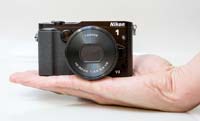 | 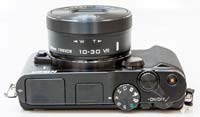 |
| Front | Top |
The Nikon V3's Scene Auto Selector is a smart auto mode in which the camera analyses the scene in front of its lens and picks what it thinks is the right mode for that particular scene. You can also choose one of the conventional PASM modes, which give you full menu access and the ability to manually set the aperture, shutter speed, or both (Program AE Shift is available in P mode).
Auto ISO comes in three flavours (Auto 160-800, 160-3200 or 160-6400), allowing you to specify how high you want the camera to go when the light gets low. You can also choose from three AF Area modes, including Auto Area, in which the camera takes control of what it focuses on (this isn't a great mode to have as your default as the camera obviously can't read your mind and may focus on something else than your actual subject); Single Point, in which you can pick one of 171 AF points by first hitting OK and then moving the active AF point around the frame using the four-way pad; and Subject Tracking, in which you pick your subject, press OK and allow the camera to track that subject as it moves around, as long as it doesn't leave the frame of course.
The V3 is the first Nikon 1 camerato offer built-in connectivity. The wi-fi function essentially pairs the V3 with an iOS or Android smartphone or other smart device, and allows you to edit and share images directly to social networking sites like Facebook, Instagram, or Twitter. It also makes it possible to control the V3 remotely via a smart device using the free Wireless Mobile Utility app, and set the focus point using the smart device's touchscreen.
The Nikon 1 V3 has an intriguing hybrid auto-focus system that combines 171-point contrast- and 105-point phase-difference detection systems. This allows the Nikon 1 V3 to focus extremely quickly in good light, even on a moving subject. When light levels drop, the camera switches to contrast-detect AF which, though faster than on most cameras, isn't nearly as fast as the other method. It's always the camera that decides which AF method to use - the user has no influence on this.
Generally speaking, the V2 will usually only resort to contrast detection when light levels are low. Manual focusing is also possible, although the Nikon 1 lenses do not have focus rings. If you want to focus manually, you first have to go into the main menu, find the Focus Mode option, choose Manual Focus, press OK and then use the scroll wheel to adjust focus. To assist you with this, the Nikon V3 magnifies the central part of the image and displays a rudimentary focus scale along the right side of the frame - but those are the only focusing aids you get. There's also a handy new peaking function available.
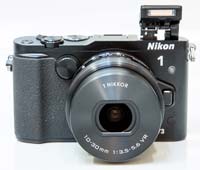 | 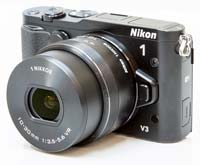 |
| Pop-up Flash | Side |
As noted earlier, you can choose from two different shutter types when shooting stills, mechanical or electronic. The mechanical shutter is the way to go if you shoot with flash as it can sync at shutter speeds as fast as 1/250th of a second. The Nikon 1 V3 has an on-board flash with a guide number of 6.3m, but it still cannot accommodate the regular Nikon Speedlights, although it is compatible with the tiny SB-N7 that slots into the top of the camera. With the mechanical shutter selected, the Nikon V3 can shoot as fast as about 6 frames per second, with auto-focus. In continuous shooting mode, the EVF freezes for a split second after each shot, but with some practice, you will be able to track your subject unless it moves in a completely erratic fashion. The shutter is not very loud but you can hear the sound of the motor that's used to cock it.
In most shooting situations, you will probably want to use the electronic shutter as it's completely silent (the focus confirmation beep can be disabled from the menu), allows the use of shutter speeds as fast as 1/16,000th of a second and, with the Electronic Hi setting selected, lets you shoot full-resolution stills at 60 frames per second. Note however that while this is a major achievement, it's limited by a buffer that can only hold 40 raw files. Additionally, the use of this mode precludes AF tracking - you have to lower the frame rate to a still very fast 20fps if you want that - and the viewfinder goes blank while the pictures are being taken. About the only application we can think of where shooting full-resolution stills at 60fps could really come in handy is AE bracketing for HDR imaging. At this rate, a series of 5 bracketed shots could be taken in less than 0.1 second, rendering small movements that can otherwise pose alignment problems - like leaves being blown in the wind - a non-issue. Alas, the Nikon V3 still doesn't offer such a feature - in fact it does not offer autoexposure bracketing at all, something that was also missing in the V2.
The Nikon 1 V3 can be set to shoot Full HD video footage, and you get to choose from 1080p at 60fps or 30fps or 1080i at 60fps, a step-up from the V2's 60i mode. If you don't need Full HD, there's also 720p at 60fps, which is really smooth and still counts as high definition. Secondly, you get full manual control over exposure in video mode. This is an option; you don't have to shoot in M mode but you can if that's what you need. Thirdly, you get fast, continuous AF in video mode, and it works well, especially in good light. Movies are compressed using the H.264 codec and stored as MOV files.
There are separate shutter release buttons for stills and video, and thanks to this - as well as the massive processing power of the Nikon V3 - you can take multiple full-resolution stills even while recording HD video. This works in the other way round too - you can capture a movie clip even when the mode dial is in the Still Image position, simply by pressing the red movie shutter release. We found that in this case the camera will invariably record the video at 720p/60fps. New to the V3 is the Auto Image Capture mode, which analyses every video frame and automatically records a sill image when conditions are best, while the addition of Fast Motion, Jump Cut, and 4-Second Movie modes extend the V3's video versatility even further.
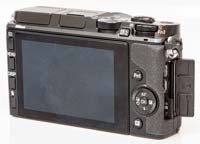 | 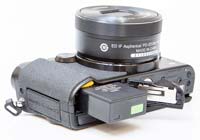 |
| Memory Card Slot | Battery Compartment |
In addition to being capable of shooting regular movies in HD quality, the Nikon 1 V3 can also shoot video at 400fps for slow-motion playback. The resolution is lower and the aspect ratio is an ultra-widescreen 2.67:1, but the quality is adequate for YouTube, Vimeo and the like. These videos are played back at 30fps, which is more than 13x slower than the capture speed of 400fps, allowing you to get creative and show the world an array of interesting phenomena that happen too quickly to observe in real time. The Nikon V3 goes even further by offering a 1200fps video mode, but the resolution and overall quality is too poor for that to be genuinely useful.
There are now three Best Moment Capture modes. Smart Photo Selector allows the camera to capture no less than 20 photos at a single press of the shutter release, including some that were taken before fully depressing the button. The camera analyses the individual pictures in the series and discards 15 of them, keeping only the five that it thinks are best in terms of sharpness and composition. This feature can be genuinely useful when photographing fast action and fleeting moments. The new Active Selection mode takes up to 40 full-resolution shots in less than a second and lets you choose the one to keep. The Slow View mode captures up to 40 full-resolution continuous shots and displays them in slow motion on the LCD screen, making it easier for you to select the exact moment that you want to keep from the burst sequence.
The new Creative Palette is available in the camera’s Creative Mode and effectively allows you to adjust the brightness, saturation simply by sliding your finger around the ring on the touchscreen or by rotating the multi selector dial, with a live preview before the picture is taken. In the innovative Motion Snapshot mode the camera records a brief high-definition movie - whose buffering starts at a half-press of the shutter release, so again includes events that had happened before the button was fully depressed - and also takes a still photograph. The movie and the still image are saved in a single MOV file.
The Nikon V3 now stores photos and videos on microSD/SDHC/SDXC memory cards, seemingly a consequence of the camera's reduction in size. The V3 runs on the new EN-EL20a Lithium-ion battery which is capable of producing the same amount of shots on a single charge, 310, as its predecessor. The camera's tripod socket is made of metal and is positioned in line with the lens' optical axis. This also means that changing batteries or cards is possible while the V3 is mounted on a tripod, as the hinges of the battery/card compartment door in the handgrip are positioned far enough away from the tripod mount.

0 comments:
Post a Comment